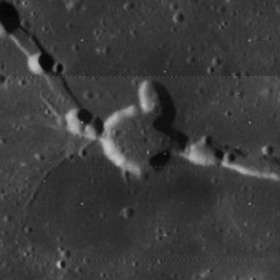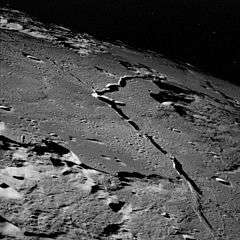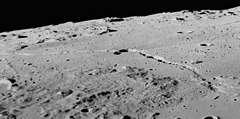Hyginus (crater)
 Lunar Orbiter 4 image | |
| Coordinates | 7°48′N 6°18′E / 7.8°N 6.3°ECoordinates: 7°48′N 6°18′E / 7.8°N 6.3°E |
|---|---|
| Diameter | 11 km |
| Depth | 0.8 km |
| Colongitude | 354° at sunrise |
| Eponym | C. Julius Hyginus |
.png)


Hyginus is a small lunar caldera located at the east end of the Sinus Medii. Its rim is split by a long, linear rille Rima Hyginus that branches to the northwest and to the east-southeast for a total length of 220 kilometers. The crater is deeper than the rille, and lies at the bend where they intersect. Together the crater Hyginus and Rima Hyginus form a distinctive and prominent feature in an otherwise flat surface. Smaller craterlets can also be discerned along the length of this rille, possibly caused by a collapse of an underlying structure.
Hyginus is one of the few craters on the Moon that was not created as a result of an impact, and is instead believed to be volcanic in origin. It lacks the raised outer rim that is typical with impact craters.
Hyginus was also considered a possible landing site during the Apollo Program, because it was thought to possibly be a site of active volcanism.[1]
Satellite craters
By convention these features are identified on lunar maps by placing the letter on the side of the crater midpoint that is closest to Hyginus.
| Hyginus | Latitude | Longitude | Diameter |
|---|---|---|---|
| A | 6.3° N | 5.7° E | 8 km |
| B | 7.6° N | 5.1° E | 6 km |
| C | 7.7° N | 8.3° E | 5 km |
| D | 11.4° N | 4.3° E | 5 km |
| E | 8.7° N | 8.5° E | 4 km |
| F | 8.0° N | 8.6° E | 4 km |
| G | 11.0° N | 6.0° E | 4 km |
| H | 6.0° N | 7.0° E | 4 km |
| N | 10.5° N | 7.4° E | 11 km |
| S | 6.4° N | 8.0° E | 29 km |
| W | 9.7° N | 7.7° E | 22 km |
| Z | 8.0° N | 9.5° E | 28 km |
References
- C.G. Wood (2006). "The Moon's Mystery Rilles". Sky & Telescope. 112 (3): 54–55.
- Andersson, L. E.; Whitaker, E. A. (1982). NASA Catalogue of Lunar Nomenclature. NASA RP-1097.
- Blue, Jennifer (July 25, 2007). "Gazetteer of Planetary Nomenclature". USGS. Retrieved 2007-08-05.
- Bussey, B.; Spudis, P. (2004). The Clementine Atlas of the Moon. New York: Cambridge University Press. ISBN 978-0-521-81528-4.
- Cocks, Elijah E.; Cocks, Josiah C. (1995). Who's Who on the Moon: A Biographical Dictionary of Lunar Nomenclature. Tudor Publishers. ISBN 978-0-936389-27-1.
- McDowell, Jonathan (July 15, 2007). "Lunar Nomenclature". Jonathan's Space Report. Retrieved 2007-10-24.
- Menzel, D. H.; Minnaert, M.; Levin, B.; Dollfus, A.; Bell, B. (1971). "Report on Lunar Nomenclature by the Working Group of Commission 17 of the IAU". Space Science Reviews. 12 (2): 136–186. Bibcode:1971SSRv...12..136M. doi:10.1007/BF00171763.
- Moore, Patrick (2001). On the Moon. Sterling Publishing Co. ISBN 978-0-304-35469-6.
- Price, Fred W. (1988). The Moon Observer's Handbook. Cambridge University Press. ISBN 978-0-521-33500-3.
- Rükl, Antonín (1990). Atlas of the Moon. Kalmbach Books. ISBN 978-0-913135-17-4.
- Webb, Rev. T. W. (1962). Celestial Objects for Common Telescopes (6th revised ed.). Dover. ISBN 978-0-486-20917-3.
- Whitaker, Ewen A. (1999). Mapping and Naming the Moon. Cambridge University Press. ISBN 978-0-521-62248-6.
- Wlasuk, Peter T. (2000). Observing the Moon. Springer. ISBN 978-1-85233-193-1.
External links
| Wikimedia Commons has media related to Hyginus (crater). |
Related articles
- Wood, Chuck (November 13, 2007). "Numbering the Marvels". Lunar Photo of the Day. Archived from the original on September 10, 2017.
- Wood, Chuck (November 15, 2007). "Colorful Interpretation". Lunar Photo of the Day. Archived from the original on September 10, 2017.
- Wood, Chuck (March 20, 2010). "Another Ina?". Lunar Photo of the Day.